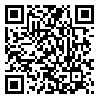Volume 16, Issue 37 (9-2020)
goljaam 2020, 16(37): 41-58 |
Back to browse issues page
1- PhD. Student, Department of Art Studies,Faculty of Research Excellence in Art and Entrepreneurship, Art University of Isfahan.
2- Dean of Faculty of Research Excellence in Art and Entrepreneurship,Department of Art studies,Art University of Isfahan.
2- Dean of Faculty of Research Excellence in Art and Entrepreneurship,Department of Art studies,Art University of Isfahan.
Abstract: (6199 Views)
After a survey on one hundred and thirty samples of Kurmanji Kilims and extraction of their natural motifs, this study is trying to propose a typology of this motifs and characterize their methods of composition. The data reviewed in this article, have been gathered in a field and documentary research. The patterns of the Kurmanji Kilim can be categorized into four groups: 1. Natural motifs, 2. Motifs derived from tools of everyday life, 3. Abstract motifs, 4. Geometric motifs; which natural motifs are the most numerous and diverse group among them. Due to the Kormanjs dependency on geographic and environmental factors, nature has become a tremendous and mythical power in their minds. Natural motifs in Kurmanji Kilim are classified into three groups: 1. Animal motifs, represented in figurative, imaginary or symbolic styles (such as peacock, duck, chicken, cock, eagle, camel, deer, ram, dog, goat, butterfly, sparrow, fox, etc.); 2. Plant motifs (such as dandelion and different kinds of flowers, trees or herbs); 3. Motifs taken from natural phenomena (such as: star, spring and mountain). Relationship with nature is also obvious in the composition of these motifs on a Kilim. Most of the context patterns are more directly related to the weavers’ everyday life, while margin patterns are usually inspired by the nature around their tribal life or their symbolic and imaginary thoughts.
Article number: 3
Type of Study: Research |
Received: 2019/06/13 | Accepted: 2021/05/3 | Published: 2021/06/12
Received: 2019/06/13 | Accepted: 2021/05/3 | Published: 2021/06/12
| Rights and permissions | |
 |
This work is licensed under a Creative Commons Attribution-NonCommercial 4.0 International License. |



